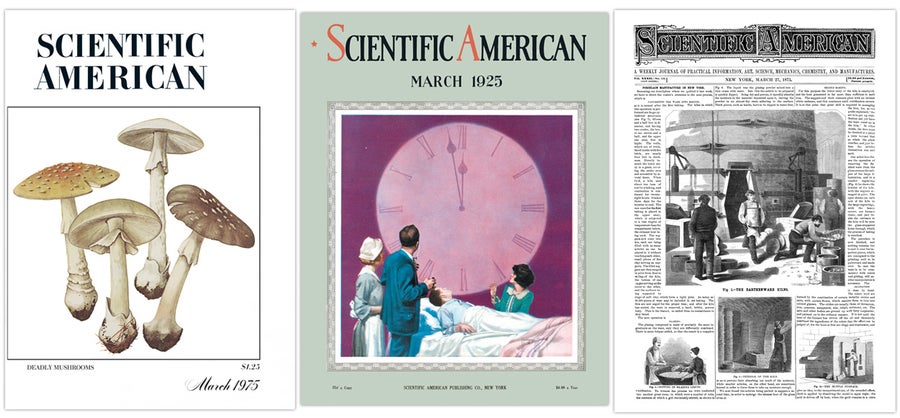February 18, 2025
3 min read
Science History from 50, 100 and 150 Years Ago
Color blindness; the end of fire

1975, Color Blindness: “People with protanopia cannot distinguish between green and red or colors in between. Color blocks (top row) simulate the appearance of lights that they judge as identical. People with deuteranopia also cannot distinguish between red, green or colors in between. Color blocks (middle row) simulate lights they regard as identical. People with anomalous trichromacy can sense red, green and blue to match all colors but require unusual proportions (bottom row); when asked to match a yellow (center), they may select a pink (left) or a green (right).”
Scientific American Vol. 232, No. 3, March 1975
1975
Chemical Warfare Ill Defined
“Biological weapons have been negotiated out of the arsenals of most of the world’s major military powers, and poison gas may be on the way out. In January the U.S. acceded to the Geneva Protocol of 1925, banning any first use of gas and bacteriological weapons, and to the Biological Weapons Convention of 1972. This month the Conference of the Committee on Disarmament is scheduled to meet in Geneva to take up proposed treaties that would move the world toward actual chemical disarmament. That will involve troubled issues of verification and inspection, however, and a major difference in definition: the U.S., unlike the rest of the world, has held that riot control gases and herbicides—both of which the U.S. deployed in the Vietnam war—are not agents of chemical warfare.”
On supporting science journalism
If you’re enjoying this article, consider supporting our award-winning journalism by subscribing. By purchasing a subscription you are helping to ensure the future of impactful stories about the discoveries and ideas shaping our world today.
Tokamak Fusion by 1980
“The Ford Administration has decided to include in the Federal budget for fiscal year 1976 a request for some $7.5 million to start work on a major new fusion-power test facility at Princeton University. If the funds are approved, detailed design of the proposed installation could begin almost immediately, with component fabrication and site construction scheduled to get underway late next year. The machine would be a plasma-confinement system known generically as a tokamak. Assuming that everything goes according to plan, the experimental fusion reactor, the first U.S. system of its kind that is expected to reach the ‘breakeven’ threshold for net power output, would be finished and ready for operation by 1980, at a projected cost of approximately $215 million.”
The Tokamak Fusion Test Reactor began operation in 1982. It produced significant energy output but never reached breakeven. It was shut down in 1997.
1925
The End of Fire
“Great changes in human affairs take place inconspicuously. The substitution of iron for bronze, of the printing press for the scribe and of mechanical power for human labor, occurred so gradually that probably people hardly appreciated its significance. A cultural change is now in progress that promises to be as profoundly revolutionary—the gradual abandonment of humans’ most ancient tool: fire. The first effective step toward a fireless future was the substitution of the electric lamp for a flame for illumination. Next came the electric motor in the place of small steam engines. The next step, and the one in which the electrical industry is at present particularly interested, is the substitution of electricity for fire in producing heat for industrial purposes.”
1875
Postage Inequality
“The Congress has again looked after its own interests. By amending the postal law, the speeches of members and other stuff are to be sent free, while the postage charged to the public is doubled. There is little doubt that this tax upon the people is due to lobbying influence of the express companies. The express charge for the smallest package sent from New York to San Francisco is 75 cents; the post office carries one weighing a pound for 16 cents. The measure affects the reading public. Three cents postage must be paid on Scientific American and other large papers. A person is charged three cents to send this paper across the river from New York to Brooklyn but two cents to forward it over the ocean to London.”
Snowflake Hitchhikers
“It is difficult to believe that the pure white snowflake, which settles noiselessly upon the earth, is, after all, a scavenger of the atmosphere that absorbs into its porous substance the myriads of microscopic bodies which form atmospheric dust near the surface of the earth. M. Gaston Tissandier states that, in a drop of water obtained from a single flake and magnified 500 times, he found pieces of coal, cloth fragments, grains of starch, sandy matter and an immense variety of other substances, not a fragment of which exceeded in diameter three ten-thousandths of an inch.”


